What is the primary role of producers in a trophic level?
To consume other organisms
To decompose organic matter
To convert sunlight into chemical energy
To act as secondary consumers

The lion is one of the apex predators in the savannah food web or food chain, often hunting other animals smaller than the lion in the act of predation in the biosphere. When the lion dies, the scavengers decompose the body and return it to the soil for the primary producer to prosper. This is an illustration of the trophic level of the savannah.
Trophic levels are a structure that researchers use to organism all the organisms in a single area or biome based on the predator and prey relationship with the other organisms in the area. The structure of the trophic level will often be in the shape or form of a pyramid as the higher the trophic level the lower the number of organisms in said level.
The trophic level of an organism will easily allow the researcher or scientist to comprehensively know the relationship between the organism and the other organisms in the habitat or biome. If you want to learn more about trophic levels and their structure, you can read any of the articles above. (Good reads include Trophic Level Index, Review Lake Trophic Level Index, and Trophic Level Troubles)
Begin by picking a specific habitat or biome you would like to categorize all the organisms. This will dictate the number of organisms you will have to organize based on their trophic level. This will provide a structure that will provide you with the necessary context and theme you can use in the whole illustration.
When you have finished choosing the habitat or biome, you will now research all the organisms in the given area. This should include the various plant life, bacteria, insects, viruses, and animals living in the habitat or biome.
After the previous step, you must select an organism and research its food production and source. This will help you easily assign the organism to its appropriate trophic level.
Based on the food source of the organism, one can easily assign the organism to the correct trophic level. If the organism produces its food via sunlight, then it should be at the primary producer’s level. But if the producer has a predator, then it should be categorized accordingly in the consumers part of the trophic level.
After finishing steps 3 and 4, you must now repeat said steps until you have finished categorizing all the organisms to their appropriate trophic level. You can also arrange the organisms in a pyramid-like structure.
The five trophic levels function as categories of specific organisms that the researcher or scientist will place and add to the food chain or food web. The first and the lowest level in the trophic level is called the primary producers. These organisms often manifest as the plant life in a given biome, as they absorb nutrients from the ground and chemical energy from the sun. The second level above the primary producers is the primary consumers. The final level called the apex predator is the organism at the top of the food chain or food web that has no consumers above them in a given ecosystem. These organisms will only be reintroduced to the energy cycle through the decomposition reaction of their dead bodies via the decomposers.
The trophic structure is a pyramid-like structure that organizes the organisms in different trophic levels and biomass based on their various relationships like predator-prey, parasitism, mutualism, and commensalism. This also indicates the relationship the various organisms will have with the other organisms below their trophic level. An example of this relationship is the presence of a secondary consumer benefiting the primary producers as it reduces the total amount of organisms preying on them.
The 10% rule is a rule that governs how much potential energy is being transferred and absorbed via consumption and chemical reactions in the body. This rule states that the energy transferred between trophic levels is only capped at 10%. Primary producers produce 100% potential energy, which is reduced to 10% when the primary consumers eat the primary producer for energy. This is true between the primary, secondary, tertiary consumers, and the apex predator reaching 0.01% Energy gained by the apex predator.
The trophic level is a position an organism occupies inside a specific food web or food chain in a given ecosystem, biosphere, or biome. Being able to classify and categorize organisms on their correct trophic levels will easily allow you to create a comprehensive food chain and food web.
The lion is one of the apex predators in the savannah food web or food chain, often hunting other animals smaller than the lion in the act of predation in the biosphere. When the lion dies, the scavengers decompose the body and return it to the soil for the primary producer to prosper. This is an illustration of the trophic level of the savannah.

cmfri.org.in
Details
File Format
Size: 37 KB
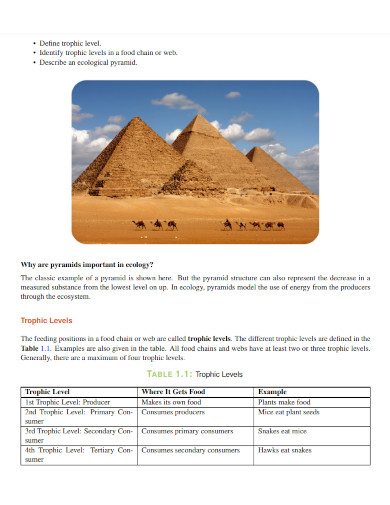
merkinms.org
Details
File Format
Size: 57 KB
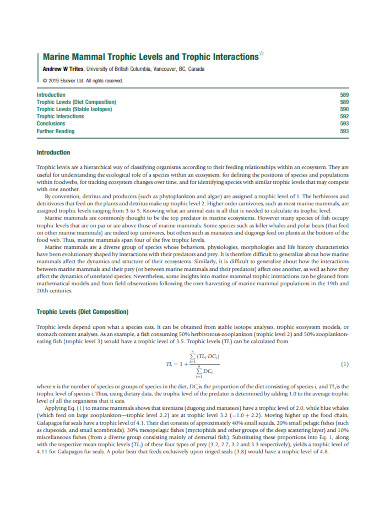
mmru.ubc.ca
Details
File Format
Size: 77 KB
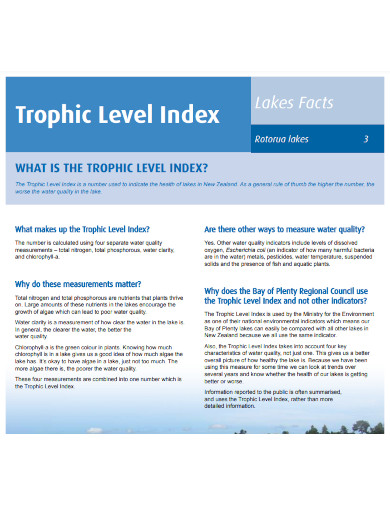
rotorualakes.co.nz
Details
File Format
Size: 67 KB
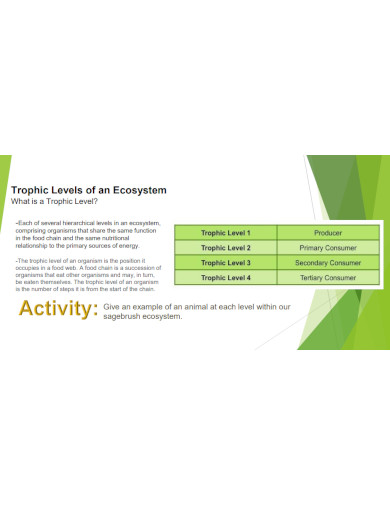
zooidaho.org
Details
File Format
Size: 26 KB
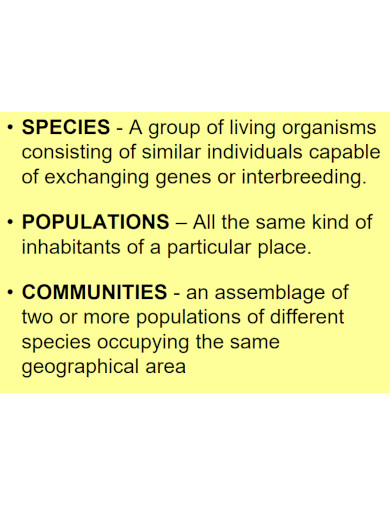
emsisd.com
Details
File Format
Size: 54 KB

teachengineering.org
Details
File Format
Size: 67 KB
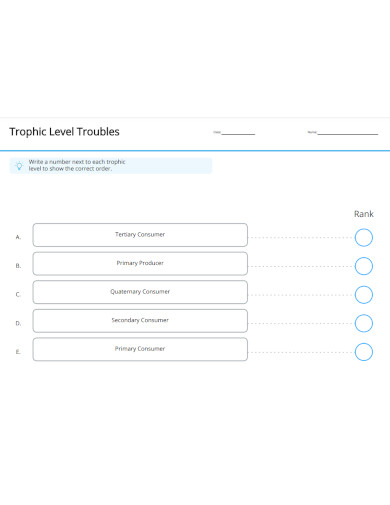
irp.cdn-website.com
Details
File Format
Size: 17 KB
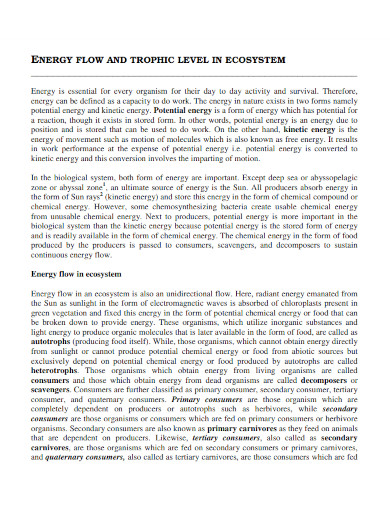
sscollegejehanabad.org
Details
File Format
Size: 109 KB
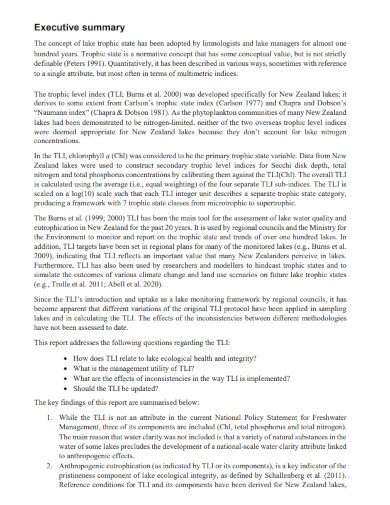
envirolink.govt.nz
Details
File Format
Size: 100 KB
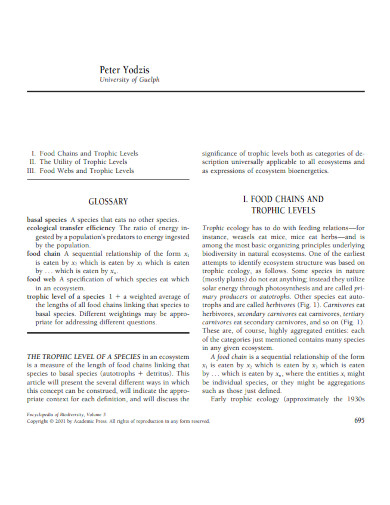
enviro2.doe.gov.my
Details
File Format
Size: 64 KB
Trophic levels are a structure that researchers use to organism all the organisms in a single area or biome based on the predator and prey relationship with the other organisms in the area. The structure of the trophic level will often be in the shape or form of a pyramid as the higher the trophic level the lower the number of organisms in said level.
The trophic level of an organism will easily allow the researcher or scientist to comprehensively know the relationship between the organism and the other organisms in the habitat or biome. If you want to learn more about trophic levels and their structure, you can read any of the articles above. (Good reads include Trophic Level Index, Review Lake Trophic Level Index, and Trophic Level Troubles)
Begin by picking a specific habitat or biome you would like to categorize all the organisms. This will dictate the number of organisms you will have to organize based on their trophic level. This will provide a structure that will provide you with the necessary context and theme you can use in the whole illustration.
When you have finished choosing the habitat or biome, you will now research all the organisms in the given area. This should include the various plant life, bacteria, insects, viruses, and animals living in the habitat or biome.
After the previous step, you must select an organism and research its food production and source. This will help you easily assign the organism to its appropriate trophic level.
Based on the food source of the organism, one can easily assign the organism to the correct trophic level. If the organism produces its food via sunlight, then it should be at the primary producer’s level. But if the producer has a predator, then it should be categorized accordingly in the consumers part of the trophic level.
After finishing steps 3 and 4, you must now repeat said steps until you have finished categorizing all the organisms to their appropriate trophic level. You can also arrange the organisms in a pyramid-like structure.
The five trophic levels function as categories of specific organisms that the researcher or scientist will place and add to the food chain or food web. The first and the lowest level in the trophic level is called the primary producers. These organisms often manifest as the plant life in a given biome, as they absorb nutrients from the ground and chemical energy from the sun. The second level above the primary producers is the primary consumers. The final level called the apex predator is the organism at the top of the food chain or food web that has no consumers above them in a given ecosystem. These organisms will only be reintroduced to the energy cycle through the decomposition reaction of their dead bodies via the decomposers.
The trophic structure is a pyramid-like structure that organizes the organisms in different trophic levels and biomass based on their various relationships like predator-prey, parasitism, mutualism, and commensalism. This also indicates the relationship the various organisms will have with the other organisms below their trophic level. An example of this relationship is the presence of a secondary consumer benefiting the primary producers as it reduces the total amount of organisms preying on them.
The 10% rule is a rule that governs how much potential energy is being transferred and absorbed via consumption and chemical reactions in the body. This rule states that the energy transferred between trophic levels is only capped at 10%. Primary producers produce 100% potential energy, which is reduced to 10% when the primary consumers eat the primary producer for energy. This is true between the primary, secondary, tertiary consumers, and the apex predator reaching 0.01% Energy gained by the apex predator.
The trophic level is a position an organism occupies inside a specific food web or food chain in a given ecosystem, biosphere, or biome. Being able to classify and categorize organisms on their correct trophic levels will easily allow you to create a comprehensive food chain and food web.
Text prompt
Add Tone
10 Examples of Public speaking
20 Examples of Gas lighting
What is the primary role of producers in a trophic level?
To consume other organisms
To decompose organic matter
To convert sunlight into chemical energy
To act as secondary consumers
In a food chain, which trophic level is typically represented by herbivores?
First trophic level
Second trophic level
Third trophic level
Fourth trophic level
Which of the following organisms is most likely to be at the top of a food chain?
Producer
Herbivore
Carnivore
Apex predator
How does energy decrease as it moves up trophic levels in a food chain?
It increases by a factor of ten
It remains constant
It decreases by a factor of ten
It doubles
What type of organisms are decomposers in an ecosystem?
Primary producers
Primary consumers
Secondary consumers
Organisms that break down dead matter
In a food web, what role do secondary consumers play?
They consume producers
They consume primary consumers
They are decomposers
They are producers
Which trophic level would a scavenger, such as a vulture, belong to?
Primary producer
Primary consumer
Secondary consumer
Decomposer
What happens to the number of organisms as you move up the trophic levels in an ecosystem?
It increases
It stays the same
It decreases
It fluctuates
Why are there generally fewer top predators in an ecosystem compared to primary producers?
Top predators are more efficient at energy conversion
Top predators have more offspring
Energy loss between trophic levels limits their numbers
Top predators consume more energy
What is the role of primary consumers in a trophic level?
To produce energy
To decompose organic matter
To consume producers and convert their energy
To consume other consumers
Before you leave, take our quick quiz to enhance your learning!

